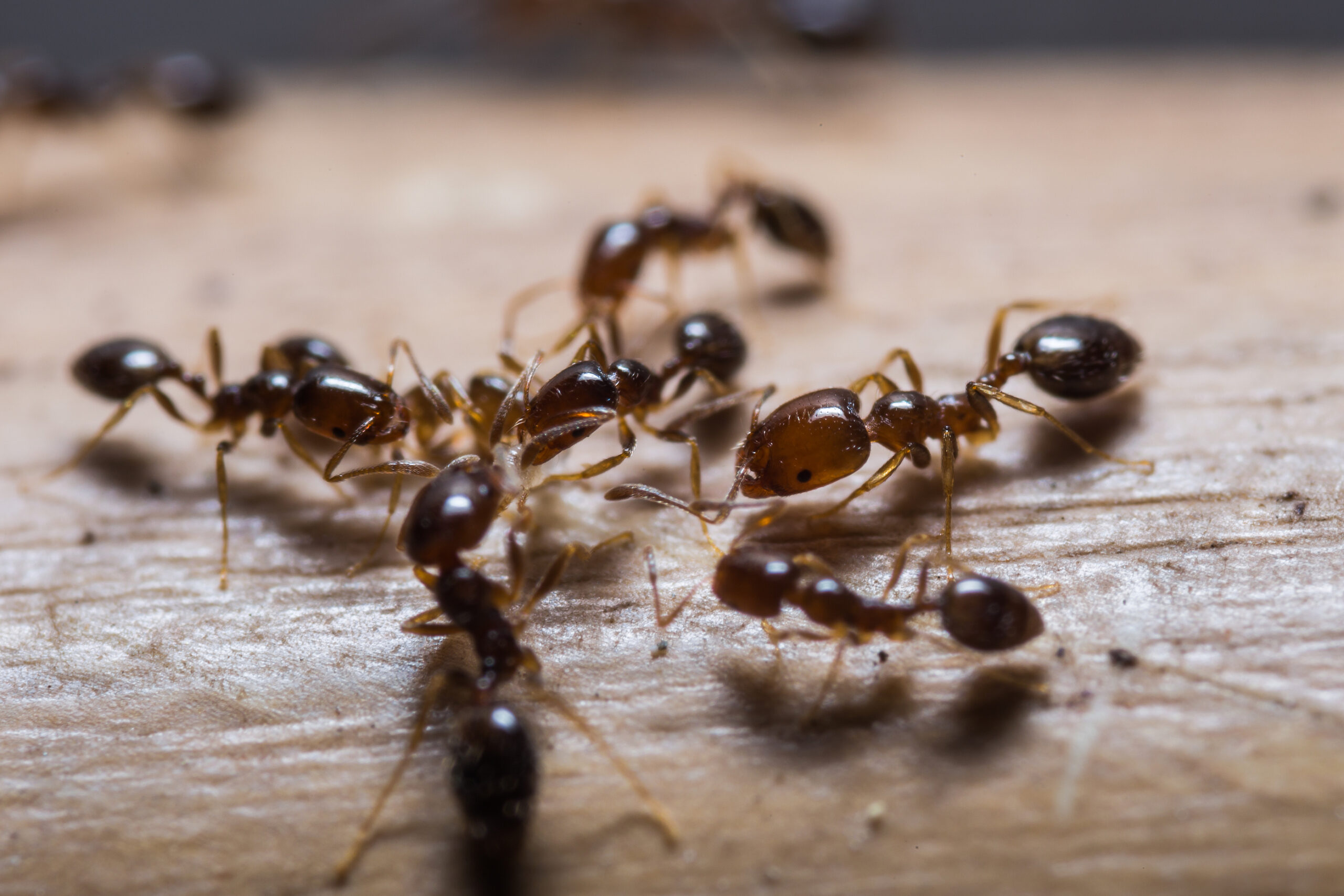
Red imported fire ants, Solenopsis invicta, form tall, hardened mounds in clay-type soil in and around poultry operations.
Imported fire ants can cause problems on poultry farms by attacking chickens and foraging on broken eggs. Fire ant stings cause blemishes that can reduce the quality of poultry. Their stings can cause medical problems or even death to some animals receiving multiple stings.
In animal feeding stations, barns and feedlots, fire ants can cause similar problems. Fire ants prey on a number of pest insects and arthropods, including many species of caterpillars, flea larvae, ticks and chiggers. They also prey on beneficial insects.
Ants defending mounds can sting and cause medical problems for workers. The ants have an affinity for electrical units, utility housings and structures, where they can cause equipment failures.
Like other ants, the fire ant is a social insect. Colonies of these ants reside under mounds of dirt that may exceed 18 inches tall. Imported fire ant mounds commonly occur in open, sunny areas in the landscape.
Winged reproductive male and female ants periodically leave the colonies on mating flights. Mated females (queens) can fly or be carried by winds for miles before landing and starting new colonies.
Development from egg to adult occurs in about 30 days, progressing though four larval stages and a pupal stage. In a mature colony, worker ants (sterile female ants that can sting) can number in the hundreds of thousands.
There are two forms of fire ant colonies: single queen (monogyne) and multiple queen (polygyne). Areas infested by the single-queen form may have 40 to 80 colonies per acre. Land infested by multiple-queen colonies can harbor 200 to 800 or more ant mounds per acre.
Worker ants from multiple-queen colonies are not territorial; they move freely from mound to mound. The opposite is true of workers from single-queen colonies.

The number of fire ant mounds can increase rapidly after agricultural lands are disturbed by mechanical operations or pesticide use. Because the ants can form a mass of floating bodies, flooding can temporarily move fire ants out of flood-prone areas and into sites that were not previously infested.
In the 1950s, the U.S. Department of Agriculture (USDA) developed a quarantine program for fire ants. The quarantine is designed to minimize the spread of imported fire ants by requiring proper treatment and inspection of all nursery stock, turf-grass, hay and other articles, including chicken litter, shipped out of quarantined counties. For specific information on compliance with these quarantine regulations, contact the Texas Department of Agriculture.
Management
Management of fire ants for caged-layer houses differs from that for broiler houses.
Program 1: For caged-layer houses
Use a combination of the following suggestions:
- On grounds surrounding the buildings, broadcast conventionally formulated bait products outside the poultry house. Products include abamectin (ClinchTM), fenoxy-carb (Award®), hydramethylnon (Amdro®), pyriproxifen (Distance®), s-methoprene (ExtinguishTM) or hydramethylnon plus methoprene (ExtinguishTM Plus). Do not allow the chickens to have access to the fire ant bait or bait-treated areas.
- If fire ants are foraging inside the poultry house from ant mounds located outdoors, spray a barrier around the outside of the building using products registered for that usage site, such as lambda-cyhalothrin.
- Use mowers or herbicides to remove the weeds and grass from around poultry houses.
- Remove food sources (trash, piled feed, broken eggs and dead chickens) and potential nesting sites (pieces of lumber, old equipment and manure piles).
- If the ants are nesting inside poultry houses, treat indoor surfaces with a registered product. Note: Although some products such as permethrin (Y-Tex® GardStar®) are registered specifically for control of fire ants in poultry houses, other products, such as cyfluthrin (CountdownTM), dichlor-vos (Vapona® Concentrate Insecticide) and lambda-cyhalothrin (GrenadeTM ER Premise Insecticide), are more generally registered for “crawling pests,” including ants. Read the poultry section of the labels for additional precautions. Do not allow the insecticides to come into contact with feed or water supplies.
Program 2: Broiler houses
Program 1 for caged-layer facilities can be adapted to broiler houses, if the products used are registered for this site. Because broilers roam freely in the houses, you must take care to prevent the chickens from having contact with the insecticides by confining treatments to the outside of the broiler house (see Step 1 above).
For more information on managing red imported fire ants, see Texas Cooperative Extension publications B- 6043, Managing Imported Fire Ants in Urban Areas, L-5070, The Texas Two-Step Method: Do-It- Yourself Fire Ant Control for Homes and Neighborhoods, or SP-196, Management of Imported Fire Ants in Cattle Production Systems.
By: Jeffery K. Tomberlin and Bart Drees
